Classification System of JR Group (formerlyJNR/JGR)
Locomotives and Rolling Stock
By Edward Talbot

C 56 44, type C56, three driving axles, tender
locomotive. Taken at Oigawa Railway, by Hiroshi Naito.
|
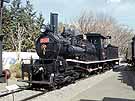
5540, type 5500, tender locomotive with four-coupled
wheels. Taken at Oume Rail Park, by Hiroshi Naito.
|
1 Steam Locomotive
1.1 Alphabet and figure system (established in 1928)
Alphabet: number of driving axles: B = 2, C = 3, D = 4, E = 5
| First and second figures: |
10 - 49: |
tank locomotive |
|
50 - 99: |
tender locomotive |
|
(60 - 62): |
converted tender locomotive |
Subsequent figures: running number of the class.
Example:
C 11 64: C (=with three driving axles), 11 (=second tank loco of
the type), 64 (=64th of the class)
1.2 Figure only system (established in 1909)
| 1 - 999: |
tank locomotive with four-coupled wheels |
| 1000 - 3999: |
tank locomotive with six-coupled wheels |
| 4000 - 4999: |
tank locomotive with eight-coupled wheels |
| 5000 - 6999: |
tender locomotive with four-coupled wheels |
| 7000 - 8999: |
tender locomotive with six-coupled wheels |
| 9000 - 9999: |
tender locomotive with eight-coupled wheels |
Note:
There are some
exceptions, such as the rebuilt 4-4-0Ts enrolled in the
1000s, the 4-6-2s which were given the extra class number of 18900
(later reclassified as C 51) etc.
The running
number of each class is principally indicated by the addition to the
class number, such as:
| of class 9600: |
9600: 1st, |
9601: 2nd, |
9699: 100th, |
19600: 101st, |
79669: 770th |
| of class 8620: |
8620: 1st, |
8621: 2nd, |
8699: 80th, |
18620: 81st, |
88666: 687th |

AC locomotive EF 70 1001, type EF70. Numbered in the
1000s represents high-speed hauling of limited express passenger
trains. Taken at Usui Railway Cultural Village, by Hiroshi Naito.
|
2 Electric Locomotive
First alphabet: E for "electric"
Second alphabet: number of driving axles:
B = 2, C = 3, D = 4, E = 5, F = 6, H = 8
| First and second figures: |
i) 10 - 49: |
maximum speed under 85 km/h |
|
50 - 89: |
maximum speed over 85 km/h |
|
ii) 10 - 19: |
DC loco for freight service |
|
20 - 29: |
DC loco ex private railways |
|
30 - 39: |
AC/DC loco |
|
40 - 49: |
experimental loco or rack loco |
|
50 - 59: |
DC loco for passenger service |
|
60 - 69: |
DC high-powered loco |
|
70 - 79: |
AC loco |
|
80 - 89: |
AC/DC loco |
|
90 - 99: |
experimental loco |
Subsequent figures: running number of the class.
Some variants of certain classes are designated with the running
numbers of 300s, 500s, 1000s etc.
Examples:
ED 16 9: E (=electric), D (=with four driving axles), 16 (=7th
DC loco for freight service with a maximum speed under 85 km/h), 9
(=9th of the class ED 16)
ED 81 301: E (=electric), F (=with eight driving axles), 81 (2nd
AC/DC loco with a maximum speed over 85 km/h), 301 (=1st of the EF 81
300s, a variant of class EF 81 with an unpainted stainless steel body
for the operation at the Kanmon undersea tunnel)
Note:
Before this classification system was established (principally) in
1928, the electric locos in those years had been given such class
numbers as 1000, 1040, 8000, 10000 etc. (though having been originally
10000s, according to the classification of 1909), without alphabets.
Then, they were reclassified under the today's system (1000 = ED 10,
1040 = ED 50, 8000 = EF 50, 1000 = EC 40 etc.).
A few locos of class AB 10 (A for Accumulation) existed, as the sole
battery type. They were later rebuilt to become the normal electric
locos, class EB 10.
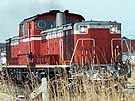
Diesel locomotive DD 51 1157, type DD51, for main line
service, maximum speed over 85 km/h. Taken at Kushiro Hokkaido, by
Hiroshi Naito.
|
3 Combustion (Diesel) Locomotive
First alphabet: D for "diesel"
Second alphabet: number of driving axles: B = 2, C = 3, D = 4, E = 5, F
= 6
| First and second figures: |
10 - 49: |
loco for shunting or local service, maximum speed under 85
km/h |
|
50 - 89: |
loco for main line service, maximum speed over 85 km/h |
|
90 - 99: |
experimental loco |
Subsequent figures: running number of the class.
Some variants of certain classes are designated with the running
numbers of 500s, 1000s, 1500s etc.
Example:
DF 50 1 - differed from DF 50 500 - in the power and
maker of the diesel engine.
DD 51 801: D (=diesel), D (=four driving axles), 51 (=2nd loco
for main line service with a maximum speed over 85 km/h), 801 (=1st of
the DD 51 800s and 1800s, a variant having no steam generator).
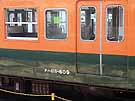
Control car ku ha 111 609, type 111, DC, suburban
service railcar. At Tokyo station, by Hiroshi Naito.
|
4 Electric Railcar
Each example of electric railcars is classified with katakana (a
Japanese syllabary) and figures, e.g. ku mo ha 103, sa ro
111
etc. And the classes composing a train set or multiple unit are grouped
as series, which is designated with the number of the main railcar
(i.e. of the motor coach with odd number). For example, series 481 is
comprised of the five classes of mo ha 481, mo ha 480, ku
ha 481, sa ro 481 and sa shi 481.
What the symbol letters and figures mean are as follows:
| ku: |
control car |
| mo: |
motor car |
| sa: |
trailer |
| ro: |
first class (second class, before 1960) |
| ha: |
second class (second class, before 1960) |
| shi: |
dining or buffet |
| ne: |
sleeping |
| yu: |
mail |
| ni: |
baggage |
| e: |
rescue |
| ru: |
distribution |
| ya: |
service or inspection |
10 - 99: older type
Above 100: modern, high-powered
type (the following is only for the above 100 types:)
| First figure: |
1 - 3: |
DC railcar |
|
4, 5: |
AC/DC railcar |
|
7, 8: |
AC railcar |
| Second figure: |
0 - 2: |
railcar for commuter or suburban service |
|
3: |
- |
|
4: |
non-multiple unit DC car; "14-" only |
|
5 - 7: |
railcar for express service |
|
8: |
railcar for limited express service |
|
9: |
experimental car or service car |
Third figure:
running number
(0 - 9) of each type; principally a pair of serial odd
and even numbers are applied to one series, which is represented by the
larger, odd number (i.e. 1 to 0, 3 to 2).
Subsequent figures (starting from 000 [older type] or "-1" [modern
type]): running number of the class.
Examples:
mo ha 480-27: mo (=motor car), ha
(=second class), 4 (=AC/DC
railcar), 8 (=for limited express service), 0 (=2nd [subsequent to
class mo ha 481] of this type i.e. of the "mo ha 48-"), -27 (=27th of
the mo ha 481)
sa ro 111-85: sa (=trailer), ro
(=first class), 1 (=DC railcar),
1 (=for suburban service), 1 (=1st of this type i.e. of the "sa ro
11-"), -85 (=85th of the sa ro 111).
ku mo ha yu ni 44001: ku (=with control
cab), mo (=motor car),
ha (=second class), yu (=mail), ni (=baggage), 4 (=older type DC
railcar), 4 (=5th of this type i.e. of the "ku mo ha yu ni 4-"), 001
(=2nd of the mu mo ha yu ni 44).
Note:
Some variants of
certain classes (or serieses) are designated with the
running numbers of 500s, 1500s etc. (e.g. series 183-1000s, as well as
series 113-1000s, are fitted with the special safety equipment to cope
with a line leading to the subterranean platforms of
Tôky�EStation).
Until the 1950s, the motor cars with control cabs were given no "ku",
since every motor car had had the cab before then (i.e. before the
series 80 appeared).
In the earlier
years of the JGR (later JNR) classification system,
in place of the "mo" the "de" was used, along with the numbers in three
or four figures, to indicate the motor car (this sign is still today
prevailing on many of the private railways). In those days, there were
such classes as ho de 6100 (ho: cf. the below section of Passener Car),
de ha 6340 etc.
5 Combustion (Diesel) Railcar
Each type of combustion railcars is classified with katakana (a
Japanese syllabary) and figures, e.g. ki ha 20, ki ro 80
etc. And the classes composing a train set or multiple unit are grouped
as series, which is designated with the number of the prototype of the
series. For example, series 181 DMU consists of the five classes ki
ha 181, ki ro 181 and ki sa shi 181.
What the symbol letters and figures mean are as follows:
| ki: |
diesel railcar (formerly including gasoline or steam type) |
| ki ku: |
control car (without driving power unit) for DMU |
| ki sa: |
trailer (without driving power unit) for DMU |
| ro: |
first class (second class, before 1960) |
| ha: |
second class (second class, before 1960) |
| shi: |
dining or buffet |
| yu: |
mail |
| ni: |
baggage |
| ya: |
service car or inspection car |
| wa: |
freight wagon |
i) 01 - 99: older
or conventional type
| First figure: |
0: |
miscellaneous type (non-hydraulic) |
|
1 - 4: |
hydraulic one-engine type |
|
5: |
hydraulic two-engine type |
|
6, 7: |
hydraulic high-powered one-engine type |
|
8: |
hydraulic type for limited express |
|
9: |
hydraulic experimental car |
Second figure: running number (0 -
9) of each type
Subsequent
figure(s):
running number of the class
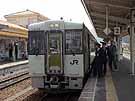
Diesel Railcar k1 ha 112 115, modern, high-powered new
serial type. At Hitachi-Daigo station, by Hiroshi Naito.
|
ii) 100 -399: modern, high-powered new serial type
| First figure: |
1, 2: |
hydraulic type |
|
3: |
gas turbine engine type |
| Second figure: |
8: |
limited express type |
|
9: |
experimental car |
Third figure: running number (0 - 9) of each type
Subsequent figure(s): running number of the class. Some variants
of certain classes are designated with the running numbers of 600s,
1000s, 1200s etc.
Examples:
ki ha 2051: ki (= combustion railcar), ha (=second class), 20
(=hydraulic one-engine type), 51 (=51st of the ki ha 20).
ki sa shi 181-2: ki sa (=trailer for DMU), shi (=dining car), 1
(=modern high-powered hydraulic type), 8 (=for limited express
service), 1 (=1st of this type i.e. of the "ki sa shi 18-"), 2 (=2nd of
the ki sa shi 181).
Note:
Of the railcars with driving unit, the control cab is not designated in
the classification (apart from the electric railcars), probably because
most of conventional motorised cars had the cab.
As to the series of conventional combustion railcars the main classes
which represent the serieses are not always given the odd numbers.
Supposedly because the combustion railcars were constructed without
regard to the idea of "series" until recent years, even though some
preceding classes built unter the serial plans could be grouped as
series. As such, serieses 28, 58, 80 etc. exist.
Until the 1950s the combustion railcars were classified with the symbol
letters and numbers in four and five figures, such as ki ha ni 5000,
ki ha 42000 (= ki ha 07) etc.
In their earlier years, to identify the steam-propelled railcars the
symbol letters of ho ji, and then of ji ha, were used along with the
numbers of 6000s, such as ho ji 6005, ji ha ni 6055, ki
ha ni 6450 (ho: cf. the below section of Passenger Car, ji: steam).
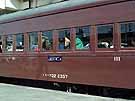
su ha fu 32 2357 passenger car, over 42.5 t and under
47.5 t, second class, with brake cabin. Taken at Chichibu Railway, by
Hiroshi Naito.
|
6 Passenger Car
Each type of passenger car is classified with katakana (a Japanese
syllabary) and figures, e.g. su ha ni 35,, na ro 10
etc. And the group of the classes built under the same serial design is
called "series", represented by the number of the prototype class. For
example, series 20 consists of the thirteen classes na ro ne 20,
na ha ne fu 23, na shi 21, ka ni 21 etc.
What the symbol letters and figures mean are as follows:
First letter: weight (self-weight + 50 kg ( the fixed number + 1
ton as the weight of water, batteries etc.)
| ko: |
under 22.5 t |
| ho: |
over 22.5 and under 27.5 t |
| na: |
over 27.5 and under 37.5 t |
| o: |
37.5 t and under 42.5 t |
| su: |
over 42.5 t and under 47.5 t |
| ma: |
over 47.5 t and under 52.5 t |
| ka: |
over 52.5 t |
Subsequent letter(s):
| i: |
first class, before 1960 |
| ro: |
first class (second class, before 1960) |
| ha: |
second class (third class, before 1960) |
| ne: |
sleeping car |
| shi: |
dining car |
| fu: |
with brake cabin |
| te: |
observation car |
| yu: |
mail car |
| ni: |
baggage car |
| ya: |
car for service, test, inspection, instruction,
construction or ambulance |
| e: |
rescue car |
| ru: |
distribution car |
| nu: |
heating car |
| he: |
hospital car (war time) |
Class number
(subsequent to letters):
Miscellaneous
type (ex private railways, rebuilt from freight cars etc.)
| 100 - 999: |
four-wheeled |
| 1000 - 7999: |
eight- or twelve-wheeled |
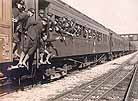
na ha 22000, eight-wheeled (body width 2,800 mm).
Photographed in 1931 on the Sanyo Main Line (location is not known).
|
Wooden body type
| 1000 - 7999: |
eight-wheeled (body width under 2,590 mm) |
| 8000 - 9999: |
twelve-wheeled (body width under 2,590 mm) |
| 10000 - 17999: |
eight-wheeled (body width over 2,590 mm and under 2,800 mm) |
| 18000 - 19999: |
twelve-wheeled (body width over 2,590 mm and under 2,800
mm) |
| 20000 - 27999: |
eight-wheeled (body width 2,800 mm) |
| 28000 - 29999: |
twelve-wheeled (body width 2,800 mm) |
The running
number of the class is indicated by adding the individual number to the
class number (starting from the 0).
Standard steel
body type
| First figure: |
1: |
lightweight construction car |
|
2: |
car for limited express service |
|
3 - 5: |
standard type ar before lightweight construction |
|
6: |
steel body car rebuilt from a wooden type |
|
7: |
restored car from war damage |
|
8: |
coach fitted with straw mats (rebuilt from 8- type) |
| Second figure: |
i) 0 - 7: |
eight-wheeled type |
|
8, 9: |
twelve-wheeled type |
|
ii) |
running number of the type |
Subsequent figures: running number of
the class.
Some variants of
certain classes are denoted with the running number of 800s, 1000s,
2000s etc.
Examples:
na ha 22001: na (=weight over
27.5 and under 37.5 t), ha (=third
class before 1960), 22001 (2nd of the class na ha 22000 ["22000s" =
eight-wheeled coach with the wooden body of 2,800 mm in width]).
su ha fu 422001: su (=weight over
37.5 and under 42.5 t), ha
(=second class), fu (=with brake cabin), 4 (=standard type before
lightweight construction), 2 (=eight-wheeled; 3rd of the "su ha fu 4-"
type), 2001 (=1st of the su ha fu 422000s ["2000s" = equipped with
electric heating system]).
ma ni 605: ma (=weight over
42.5 and under 47.5 t), ni (=baggage
car), 6 (=steel body car rebuilt from a wooden type), 0 (=first of the
"ma ni 6-" type), 5 (=5th of the class ma ni 60).
Note:
The standard
steel body passenger cars built before World War II had
been originally given the class numbers of 30000 - 40000s, but there
were later changed to 30 - 40s (e.g. su ha 32800 ® su ha 32, su i
te 37040 ® su i te 49 etc.).
As the extra
usage of the letter "te" (for observation car), there were
"te yu" (mail car possessed by the Ministry of Communications and "te
n" (obeservation car, as well) in their earlier days.
Some converted
coaches of series 12 which are fitted with tatami (straw
mats) but not with normal seats are given the running numbers of 800s
instead of the class numbers of 80s.
The special cars
for the Imperial Family are classfied with the numbers of 1 - 999 only,
without symbol letters.

Tank car ta ki 43 119, loading weight over 25 t. At
Negishi yard, by Hiroshi Naito.
|
7 Freight car
Each type of freight wagon is classified with katakana (a Japanese
syllabary) and figures, e.g. wa ra 1, to ki 15000 etc.
What the symbol letters and figures mean are as follows:
| First letter: |
wa: |
boxcar |
su: |
iron-sided boxcar |
|
te: |
all-metal boxcar |
tsu: |
ventilated boxcar |
|
re: |
refrigerator or insulated car |
ka: |
livestock car |
|
u: |
car for pig transport |
po: |
pottery car |
|
ta: |
tank car |
mi: |
water tank car |
|
to: |
gondola car |
ri: |
gondola or hopper car for sand transport |
|
shi: |
heavy load transporter |
chi: |
flatcar |
|
ko: |
container car |
ku: |
car carrier |
|
yo: |
caboose |
ki: |
snow plow |
|
ya: |
service car |
ke: |
track scale test car |
|
sa: |
works car |
e: |
rescue car |
|
so: |
crane car |
hi: |
buffer car |
| Second letter: |
(blank): |
loading weight under 13 t |
|
mu: |
loading weight 14 - 16 t |
|
ra: |
loading weight 17 - 19 t |
|
sa: |
loading weight 20 - 24 t |
|
ki: |
loading weight over 25 t |
Subsequent letter: fu: with brake cabin
Subsequent figure(s): class number(s), to which the running numbers of
the class are added (starting from 0, in case the last figure is 0).
Examples:
wa mu 80054: wa (=boxcar), mu (=loading weight over 14 and under
16 t), 80054 (=55th of the class wa mu 80000).
to 16: to (=gondola car), without the second letter (=loading
weight under 13 t), 16 (=16th car of the class to 1).
ta ki 13002: ta (=tank car), ki (=loading weight over 25 t),
13002 (=1003rd of the class ta ki 3000).
ko ki fu 50000: ko (=container car), ki (=loading weight over 25
t), fu (=with brake cabin), 50000 (=1st of the class ko ki fu 50000).
ki 103: ki (snow plow without driving unit), 103 (=4th of the
class ki 100).
Note:
Regarding the class numbers, there is no remarkable numbering system,
except 10000s being for freightliners etc.
Supplement
Some types of locomotives and rolling stock, such as rack locos, ex
private railway electrics, coaches with wooden body, ventilated boxcars
etc. etc., have been already extinct.
In 1969, the JNR introduced the mono-class system in passenger system.
So, officially they call the above-mentioned first and second class
cars special (in nickname "green") cars, as well as the first and
second sleepers A and B (-grades) sleepers, respectively.
[Home Page]








